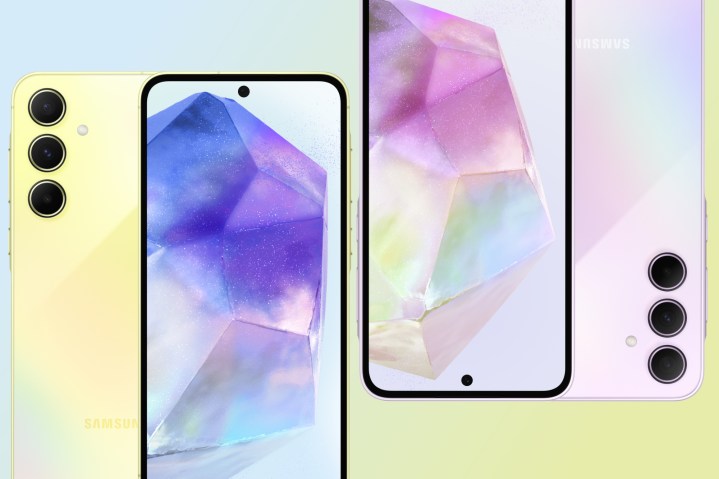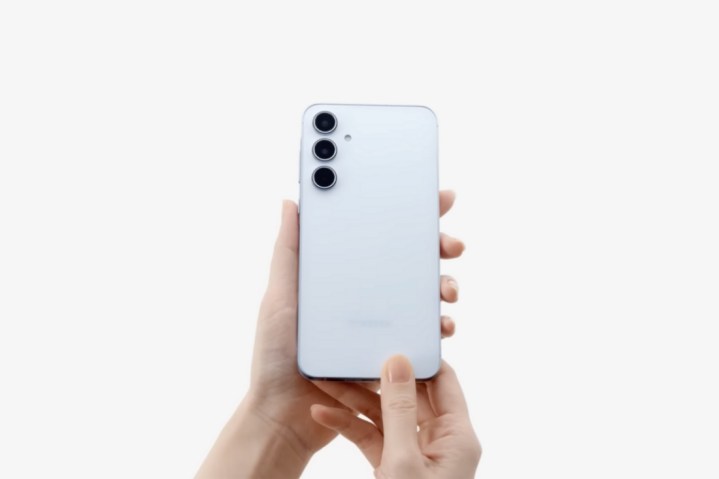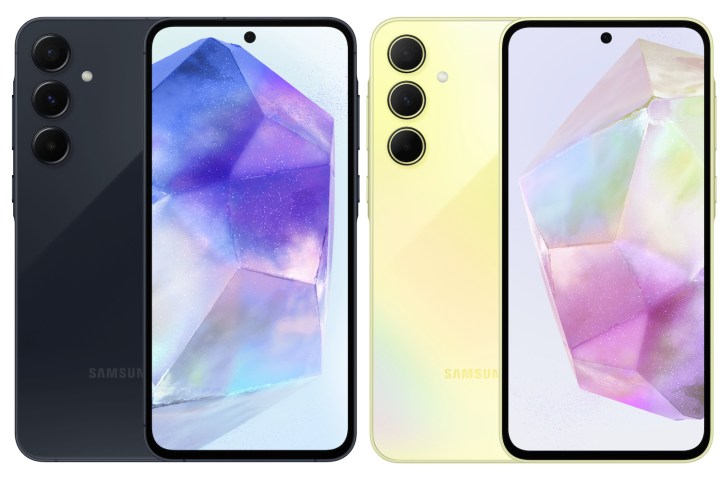
Samsung has recently introduced its latest mid-priced smartphones, the Galaxy A55 and Galaxy A35. Although these models are not as powerful as the Samsung Galaxy S24 series, they provide excellent value for their price tags. Despite diverging in some areas, the Galaxy A55 and Galaxy A35 are more alike than they are different.
- Samsung Galaxy A55 vs. Galaxy A35: specs
- Samsung Galaxy A55 vs. Galaxy A35: design and display
- Samsung Galaxy A55 vs. Galaxy A35: performance and battery
- Samsung Galaxy A55 vs. Galaxy A35: cameras
- Samsung Galaxy A55 vs. Galaxy A35: price and availability
- Samsung Galaxy A55 vs. Galaxy A35: which one should you buy?
Let’s take a closer look at both models to help you decide which phone suits your needs the best.
Samsung Galaxy A55 vs. Galaxy A35: specs
| Galaxy A55 | Galaxy A35 | |
|---|---|---|
| Weight | 7.51 oz (213.0 g) | 7.37 oz (209.0 g) |
| Dimensions | 6.34 x 3.05 x 0.32 inches (161.1 x 77.4 8.2 mm) | 6.37 x 3.07 x 0.32 inches (161.7 x 78.0 x 8.2 mm) |
| Screen size, specs | 6.6-inch FHD+ Super AMOLED Display
Up to 120Hz refresh rate Vision Booster Corning Gorilla Glass Victus |
6.6-inch FHD+ Super AMOLED Display
Up to 120Hz refresh rate Vision Booster Corning Gorilla Glass Victus |
| Screen resolution | 2340 x 1080 PPI
1,000 nits peak brightness |
2340 x 1080 PPI
1,000 nits peak brightness |
| Operating system | Android 14
One UI 6.1 Four years of Android OS and One UI updates Five years of security updates |
Android 14
One UI 6.1 Four years of Android OS and One UI updates Five years of security updates |
| Storage | 128GB or 256GB | 128GB or 256GB |
| Processor | Exynos 1480 | Exynos 1380 |
| RAM | 8GB or 12GB | 6GB or 8GB |
| Camera | 12MP Ultra-Wide Camera, f/2.2
50MP Main Camera, f/1.8, AF, OIS 5MP Macro Camera, f/2.4 32MP Front Camera, f/2.2 |
8MP Ultra-Wide Camera, f/2.2
50MP Main Camera, f/1.8, AF, OIS 5MP Macro Camera, f/2.4 13MP Front Camera, f/2.2 |
| Video | 4K (3840 x 2160) at 30 fps
1080p (1920 x 1080) at 30/60 fps 720p (1280 x 720) at 30 fps |
4K (3840 x 2160) at 30 fps.
1080p (1920 x 1080) at 30/60 fps 720p (1280 x 720) at 30 fps |
| Security | Samsung Knox Vault | Samsung Knox Vault |
| Resistance | IP67 water resistance | IP67 water resistance |
| Battery | 5,000mAh
Support for 25W fast wired charging |
5,000mAh
Support for 25W fast wired charging |
| Colors | Iceblue, Lilac, Navy, Lemon | Iceblue, Lilac, Navy, Lemon |
| Price | From around $564 | From around $435 |
Samsung Galaxy A55 vs. Galaxy A35: design and display

The Galaxy A55 and Galaxy A35 both feature a 6.6-inch FHD+ Super AMOLED display with a refresh rate of up to 120Hzthat provides users with a seamless viewing experience. The flat display comes with a hole punch in the front and uses Vision Booster technology to adjust automatically based on the surroundings. This technology enhances the visibility of content in bright sunlight or lowlight conditions, making it easier to view the display in any environment.
Both phones are available in four pastel color options: Iceblue, Lilac, Navy, and Lemon. Each color is bright and distinctive, making the phones stand out.
The two smartphones are very similar, with rounded corners and a comparable camera module layout on the back. Both phones come with three separate camera lenses. One notable difference in their design is that while the A55 has a metallic frame, the A35 is plastic.
Samsung Galaxy A55 vs. Galaxy A35: performance and battery

One area where there’s a critical difference between the Galaxy A55 and Galaxy A35 is when it comes to the chipset. The former offers a Samsung Exynos 1480, while the latter has a less powerful Samsung Exynos 1380.
The Exynos 1480 launched in March 2024 alongside the Galaxy A55. Designed using a 4nm process, the chip is aimed at providing high-end performance with improved efficiency and lower power consumption. The Exynos 1480 includes eight cores, four high-performance Cortex-A78 cores clocked at 2.75 GHz for demanding tasks and four power-efficient Cortex-A55 cores clocked at 2.0 GHz for handling lighter activities. It integrates with the Xclipse 530 GPU.
According to early benchmarks, the Exynos 1480 offers a 22% increase in CPU performance compared to its predecessor, the 2023 Exynos 1380, and a 31% jump in GPU performance. This combination should allow it to better handle graphics-intensive apps and games.
The Exynos 1380 launched in early 2023 when it debuted in the Galaxy A24. Manufactured using a 5nm process, it includes four high-performance Cortex-A78 cores clocked at up to 2.4 GHz for handling demanding tasks and four power-saving Cortex-A55 cores clocked at up to 2.0 GHz for better battery life during simpler operations. It integrates with an ARM Mali-G68 MP5 GPU running at 950 MHz, which is suitable for most everyday graphics processing needs. It’s the same chip used in the Galaxy A55’s predecessor, the Samsung Galaxy A54.
The Galaxy A55 and Galaxy A35 include a 5,000mAh battery that supports 25-watt fast wired charging. Both models should offer all-day battery life, but neither one has wireless charging.
Samsung Galaxy A55 vs. Galaxy A35: cameras

The Galaxy A55 and Galaxy A35 have somewhat different camera specifications, with the former being better. The Galaxy A55 has a 50-megapixel primary camera that captures detailed images, a 12MP ultrawide camera for wider shots, and a 5MP macro camera that lets you get close to your subjects. Its 32MP front-facing camera ensures that your selfies are sharp and clear.
The Galaxy A35 also has a 50MP primary camera and a 5MP macro camera, but it has a lower-quality 8MP ultrawide camera. Its 13MP front camera is also a noticeable downgrade.
Both phones offer 4K video recording at 30 frames per second (fps), 1080p at 30/60 fps, and 720p at 30 fps. So, whether you are recording a family event or creating a vlog, both phones can capture high-quality videos.
Samsung Galaxy A55 vs. Galaxy A35: price and availability

The Galaxy A55 and Galaxy A35 are now available in India and parts of Europe. In the following weeks, a wider release is expected in other regions.
The Samsung Galaxy A55 starts at £439 (around $564), while the Samsung Galaxy A35 starts at £339 (about $435). These prices are slightly lower than the launch prices for the Galaxy A54 and Galaxy A35 in 2023. Both phones have either 128GB or 256GB of storage.
Interestingly, Samsung has confirmed that the Galaxy A35 is coming to the U.S., but the Galaxy A55 will not. If you live in the U.S., that settles your decision of which to buy right there.
Samsung Galaxy A55 vs. Galaxy A35: which one should you buy?

Before deciding whether to invest extra money in purchasing the Galaxy A55 instead of the Galaxy A35, there are three factors to consider. The first and most significant aspect is the speed and performance. The Galaxy A55 is equipped with the Exynos 1480, which is a newer generation than the Galaxy A35’s Exynos 1380. We’ve yet to test the Exynos 1480 for ourselves, but based on the specifications, it should be a noticeable upgrade.
It is also important to look at the camera specifications. The Galaxy A55 has a 32MP front-facing camera, while the Galaxy A35 only has a 13MP selfie camera. The A55 has a 12MP ultrawide camera, while the A35 only has an 8MP ultrawide camera. However, both phones have a 50MP main camera and a 5MP macro camera, which are identical in specifications. Overall, the Galaxy A55 seems to have better camera capabilities, especially for taking selfies and wide-angle shots.
Finally, there is the difference in build quality. The Galaxy A55 has a metal frame, while the Galaxy A35 uses plastic. For some people, this is a significant difference; for others, not so much.
Editors' Recommendations
- Something odd is happening with Samsung’s two new budget phones
- Samsung has a new (and cheaper) way to buy the Galaxy S23
- Samsung just launched a $400 phone in the U.S., and it looks great
- 5 phones you should buy instead of the Samsung Galaxy S24
- Have a Samsung Galaxy S23? Don’t update your phone to One UI 6.1




